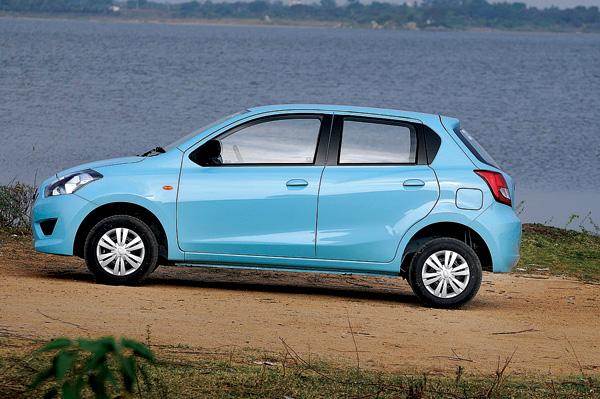Hyundai has plonked a bigger 1.0-litre petrol motor into the Eon, giving the entry-level hatchback some much needed additional power to take on its newly launched competitors – the Maruti Suzuki Celerio and the Datsun Go. The Eon now has a much more effective 65bhp – 10bhp more than the smaller 814cc engine. We compare the features and specifications of the Eon, Celerio and the Go to find out which one packs the most punch.
What they cost?
Hyundai is offering the Eon 1.0-litre in just one Magna variant which retails for Rs 3.85 lakh. In comparison, the Maruti Suzuki Celerio range starts with a price tag of Rs 3.96 lakh for the base LXi trim. The Datsun Go undercuts both its rivals with a starting price of Rs 3.12 lakh. In fact, even the top Datsun Go T variant costs Rs 3.69 lakh, considerably less expensive than competitors (all prices, ex-showroom, Mumbai).
Engines and power output
All three cars are powered by three-cylinder, petrol engines coupled to five-speed manual gearboxes. The Eon’s 1.0-litre motor is the same one used in the European-spec Hyundai i10 which makes 65bhp and 9.7kgm of torque. The Maruti Celerio gets a 998cc engine which produces a peak power of 67bhp at 6000rpm and peak torque of 9.1kgm at 3500rpm. The Datsun Go gets a bigger 1198cc engine that makes maximum power of 67bhp at 5000rpm. The bigger capacity ensures that it has an advantage when it comes to torque – the Go’s engine makes a maximum torque of 10.61kgm at 4000rpm.
Features and options
In terms of features, the top Datsun Go T variant, because of the Rs 3.69 lakh price tag outclasses its rivals. The Datsun Go T comes equipped with air conditioning, front power windows, electric power steering, central locking and wheel covers. Additionally, it gets a two-speaker audio system with aux-in compatibility (there's no radio) only, a mobile phone stand and a USB port for charging only. The on-board computer displays a digital tachometer, instantaneous and average fuel economy and distance to empty. It’s the only one among its competitors to get follow-me-home headlamps and a gear shift guide.
The 1.0-litre Eon is only available in the mid-spec Magna variant. It gets air conditioning, power steering and front power windows. In addition to this, the Eon 1.0-litre Magna gets an engine immobiliser and keyless entry but no music-system.
The Maruti Suzuki Celerio LXi gets air conditioning, power steering, key/off reminder, headlamp on reminder and engine immobiliser. The instrument cluster displays read-outs for fuel consumption, distance to empty and a digital clock.
Footprint focus
In terms of dimensions, the Datsun Go has a length of 3785mm, width of 1635mm and height of 1485mm. It is longer and wider than its competitors. The Maruti Suzuki Celerio measures in at a length of 3600mm, width of 1600mm and height of 1560mm. It is the tallest car among the trio. The Eon is smaller than its two competitors with a length of 3495mm, width of 1550mm and height of 1500mm.
Bang for the buck
The Eon 1.0 Magna, the base Maruti Celerio LXi and the top Datsun Go T variant all sport a price tag of under Rs 4 lakh (ex-showroom Mumbai). All three cars are powered by 1.0-litre, three cylinder petrol engines and come equipped with the essential features. But the Datsun Go T with its unbeatable price tag of Rs 3.69 lakh, and a spacious cabin, manages to steals the limelight from its competitors. For first time car buyers, it is difficult to overlook the value-for-money proposition of the Datsun Go.





Comments
Member Login
Personal Details
No comments yet. Be the first to comment.